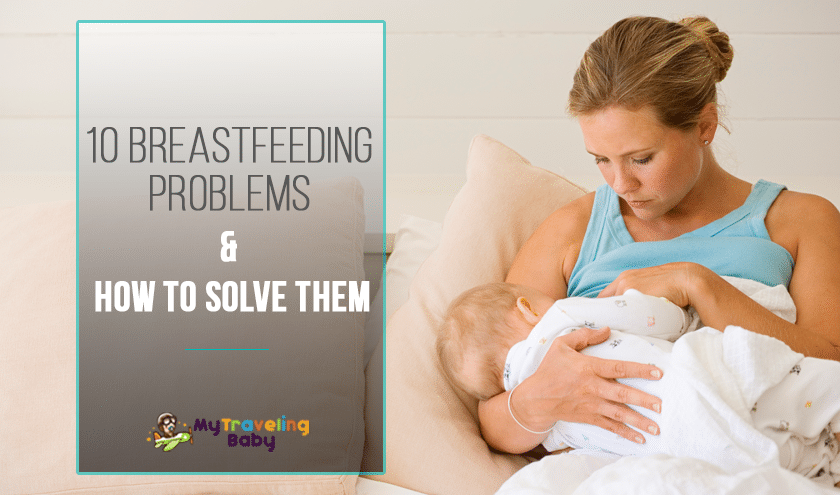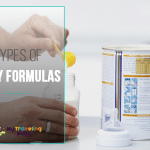
Since nursing is something that’s entirely natural, it ought to be easy, right? Unfortunately, in reality, there can be a lot of breastfeeding problems. It’s similar to learning how to ride a bicycle – it comes with a learning curve.
Here we have a list of ten common nursing problems and their solutions offered by Jane Morton, MD. She has experience in teaching lactation specialists, physicians and nurses how to teach mommies. She’s been doing it for more than thirty years and is a staff member at Lucile Packard Children’s Hospital.
Problem One: Latching Pain
It is perfectly natural for your nipples to feel a bit sore when you begin your nursing session. That especially goes for first-time breastfeeding mommies. If the pain continues for longer than a minute after your little one has latched, make sure you are in the right position.
Solution
It would be best to try an unsymmetrical latch where your infant’s mouth would cover more of the areola beneath the nipple instead of above. To change the position of your child, put your index finger inside their mouth to gently take them off your breast. You could tickle the baby’s chin or wait until their yawn with their mouth wide open and then grab the chance.
“Sandwich” your breast in order to shape it according to the infant’s mouth. When your baby is correctly positioned, their chin and nose ought to touch your bosom. Then, the baby’s lips will splay out, and you won’t be able to see your nipple or part of the low areola.
If your child is positioned correctly, and it still hurts when they latch, your nipples could be try. To avoid that, wear loose and try not to wash them with soap. It would also be great to apply Lanolin-based cream between feedings.
Problem Two: Cracked Nipples
There are various factors that contribute to the cause of cracked nipples. Some of those are pumping improperly, dry skin, and trush. However, the most likely cause is latching problems.
During your first week of nursing, you may notice a bit of blood discharging when your child is trying to latch for the first few times, or when you are starting out pumping. A bit of blood is an unpleasant sight, but not harmful to the child.
Solution
Check the position of your baby. The lower part of the areola beneath your nipple ought to be in the infant’s mouth. Nursing more frequently and at short intervals is also worth a try.
The less hungry your child is, the softer they will suck. You might be tempted to treat your cracked nipples with items from your medicine cabinet, but perfume, lotions, alcohol, and soaps will do you no good. It’s best to stick to clean water.
You can also try and let a bit of milk remain on your nipple to air dry after nursing. The milk is not only beneficial to your child, but it also helps heal your nipples. Another thing you could do is take a mild painkiller, such as ibuprofen, half an hour before breastfeeding.
In case none of this proves to be a success, there is one more thing you can try. Buy an over the counter lanolin cream. They are specially made for breastfeeding mommies and use plastic hard breast shells.
Problem Three: Clogged/Plugged Ducts
The reason why they might become clogged is that your breastmilk is not draining entirely. You might notice a hard lump on your bosom. It might also be sore to the touch, with some visible redness. If you start to feel achy or perhaps even a bit feverish, it is a sign of infection, and you must see a physician, in that case.
The most important thing is not to have long pauses in between feedings, breastmilk has to be expressed frequently. A breastfeeding bra that is excessively tight may also be a cause of clogged ducts. Stress, something that all new mothers experience, may also affect your milk supply and flow.
Solution
Try to get some proper rest. Recruit your partner to relieve you of some of your parental duties. Try to apply warm compresses to your bosoms and massage them. That way, you can stimulate breastmilk movement.
Clogged ducts sound alarming, but are not actually harmful to your infant because breast milk contains natural antibiotics. Nevertheless, there is no reason why you should endure such discomfort. Nursing should be pleasant for both the mother and her child.
Problem Four: Engorgement, Excessive Milk Supply
Engorgement can make it difficult for the infant to latch on to the nipple because it makes it too firm and un-conforming to their mouth.
Solution
You could try hard expressing a bit before nursing to get the breastmilk to flow and to soften the bosom. That way, you’ll make it easier for your little one to latch on and access milk. The more you breastfeed, chances of engorgement decrease.

Problem Five: Mastitis
Mastitis is a bacterial infection of the mammary glands. It characterized by flu-like symptoms such as fever and breast pain. It’s not an uncommon occurrence during the first couple of weeks after birth, but sometimes it also occurs during weaning. The causes of mastitis are engagement, clogged breastmilk ducts, and cracked skin.
Solution
The only proper way to treat this condition is with antibiotics, accompanied by hot compresses, and, in the main, frequent emptying. Utilize hands-on pumping to make sure the red, firm areas of the bosom are soft. It might not sound like that, but nursing is safe and highly recommended throughout the bout of mastitis.
Problem Six: Trush
Trush is a yeast infection that appears in the mouth of the baby. To make matters worse, it can spread to your breasts. If it occurs, you will notice soreness, incessant itchiness, and, occasionally, it may cause a rash as well.
Solution
Your specialist will prescribe you antifungal medicine that is applied to the nipple and in the infant’s mouth. It is crucial for both of you to be treated at the same time. Otherwise, you’d be continually giving each other fungi and prolonging the healing process.
Problem Seven: Low Milk Supply
Nursing is kind of a supply and demand process. If your physician is worried about your little one’s weight gain and is following the WHO guidelines for nursing infants, you might have this problem.
Solution
Hands-on pumping and frequent breastfeeding throughout the day can be of great help in increasing your breastmilk supply. Consuming a bigger amount of fluids and taking in more calories, or a variety of different food, has not been proven to increase breastmilk production.
Problem Eight: Infant Sleeping at Breast
Your baby will be sleepy in the first few months of their life. After all, babies do go through a lot as well in that period.
Solution
Breastmilk flows the fastest after the first let down. Starting with the fuller bosom, and then switching to the other one sooner, rather than later, is a good way of increasing efficiency. When you notice that your child is starting to suck more slowly and that their eyes are starting to close, take them off from your bosom.
After that, try to stimulate them by tickling their tiny feet or by burping. You can also try and talk to them gently while you rub their back.
When you are done, switch breasts. As your child grows, they’ll be able to stay awake for a more extended period of time, so there’s no reason to fret.

Problem Nine: Inverted or Flat Nipples
The way you can identify this problem is by a simple squeezing test. You can conduct it by gently grabbing your areola with your thumb and index finger.
If you see your nipple retracting rather than protruding, we’ve got some bad news. It’s not really a problem. It just makes nursing a bit more challenging.
Solution
Before you place your infant at your nipple, use a pump to get the breastmilk flowing. You should also use breast shells between feedings. Once you get the feeling that your breastmilk supply is good enough, you can try and use nipple shields if your little one still has difficulties latching.
Problem Ten: Painful/Overactive Let Down
Your breasts are like a couple of machines – so to speak. Once you let down, all the “milk manufacturing engines” draw together to move the breastmilk forward and out of your breasts.
Sometimes, such processes are painful, especially when in overdrive. Some mommies can experience prickly feeling while other mommies just get an achy feeling.
Solution
If the prickly feeling is not quite a pins-and-needles sensation, but more of dozens of daggers poking through your breasts feeling, you need to see if you have a fungal or bacterial breast infection. This pain can develop when you produce an excessive amount of breastmilk.
You can try and nurse your child longer on one bosom and then switch to the other only if it is necessary. If the pain is caused by an infection, your physician will prescribe you some antibiotics.



